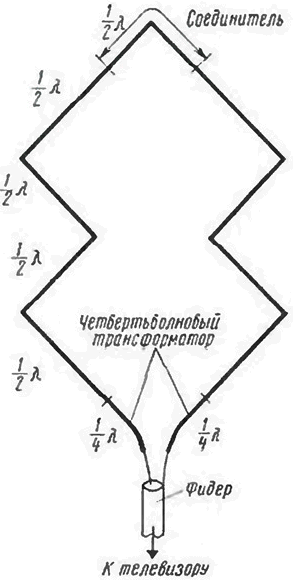Significant difficulties in ensuring high quality reception programs television usually arise where there is a large number television stations, and at different frequencies and from different directions. To use for each channel a separate directional antenna to the ordinary the user may be difficult. So the best way out - the use of ultra-wideband antennas that simultaneously receive television stations in meter and decimeter wavelengths.
A variety of options such antennas, however long ago, have been described, e.g., in [1 - 3].
Now available for sale antenna Polish production with one-pointedness in the UHF range and almost in bi-directional meter. Each of them is equipped with an antenna amplifier. However, if not properly the choice of the gain observed overloading powerful signal station and interference through cross distortion.
To repeat radio offers more than a simple TV antenna with a very big broadband. She (see schematic diagram) is a the result is a serial connection of two zigzag vibrators. And from above they shorted half-wave coupler, bottom feeder connected via quarter-wave transformer. The distance between the points of connection of feeder 1 3 see...These elements of the connection and agreement in the form of a single design with elements of the antenna, which in this case turns out to be extremely simple and easy to handle.

In the UHF band (antenna was manufactured to receive the 38th channel when the size of X/2, is equal to 24 cm) maximum sensitivity of the antenna is obtained the calculated wavelength. However, a zigzag antenna very broadband, and high-level signals they take them all the UHF band.
In the meter range, the antenna can be considered as one large loop or deformed rhombus with a resonant frequency at approximately the middle range. This provides the possibility of its application to receive television stations in this stretch frequencies.
In such a broad range of frequencies it is impossible to propose a reflector with an acceptable geometric dimensions that ensure the unidirectionality of the antenna. So it used without the reflector. The radiation pattern of this antenna has the form eight I. of course, when it is installed it is necessary to find the best orientation.
Even without the use of baluns and matching devices, i.e. with the direct connection of TV 75-Ohm cable to the antenna, you can get good results. For example, in terms of Rostov-on-don with the location of the antenna on the balcony of the 9th floor, the author successfully takes transmission television stations operating on channels 1. 7, 9. 12. 22. 32, 35, 38. 49 and 51. Moreover, the signals of the 49th channel was taken from a nearby Azov. which is when line of sight about 30 km away.
For the manufacture of the antenna can be any suitable material: aluminum or brass tube, profile or strip material. Very comfortable bimetallic (inside steel, outside - aluminium electrical wire with a diameter of 5 mm. it is Possible to use aluminium conductors from power cables. In extreme if such an antenna is permissible to make a television cable (connecting in points connect the braid to the center conductor), stretched on a wooden the crossbar of the appropriate form, using it to reduce feeder.
Literature
Author: G. Petin, Rostov-on-don






